August 14
Tony and I have arrived in Botswana a couple of days ahead of the students, and immediately headed into Moremi to a primitive camp to do some pre-safari safari-ing.
One reason to arrive early is to simply make sure we're there when the students begin arriving. Tony's flight from Newark to Washington, DC, for example, was so late that he would have missed the flight to Jo-berg. Thus, he had to immediately get re-routed and fly to Africa through Europe, arriving 14 hours later than I did. When you travel long distances with multiple airlines like this, the potential for disruption is high, and even for my students I tend to suggest that they build in an extra travel day up front for cases just this.
Case in point: the airport in Nairobi had a major fire in it recently, and much of the airport is no longer truly functional (some say it never was). This is leading to everyone having real issues with schedules if they fly through Nairobi, and that will probably continue for some time.
More important, though, is just getting back into the speed of Africa and into safari mode. Even amongst experienced wildlife photographers it sometimes takes a day or two to get fully dialed in and, after having to pack tight for travel, get everything reorganized the way you'll use it in the field. One of my cameras is in a different bag than the lens I use on it for travel weight purposes, and my camera batteries were all in my laptop bag to keep my pack weight from being too heavy. So getting everything back sorted where I want it for the actual safari is one of the things these extra days are for.
Some assembly is required, too. Likewise, I had heads in one bag, monopod and window pod in another, and I need to put the Wimberley Sidekick on the head and the head onto the window pod. It's one thing to travel by car to a location, where you can usually use more bags and keep things pretty much ready to go. But getting to a distant locale with 23kg checked bag and 18kg carry-on bag limitations really requires packing tight and efficiently, and often separating things that should be together just to keep everything airline acceptable.
So here I am typing this at Camp 9 in Moremi. And here's Tony doing whatever he's doing at the other end of the table:
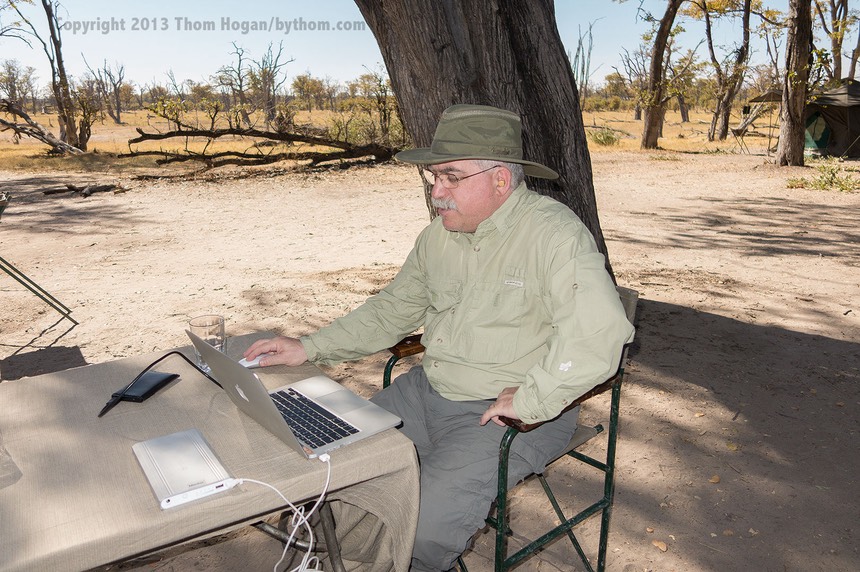
Foreshadowing: the thing I write about at the end of today's entry is barely visible in the field below the Copyright notice.
Driving in from Maun was pretty uneventful, except for our first interesting animal sighting: a very big Honey Badger. These guys are one of the toughest animals to photograph in the wild here, as they tend to bolt straight for their den hole, which is exactly what our badger did. Still, even just seeing a Honey Badger is a bit unusual, so it was nice to see one, even if he was moving lickety-split fast away from us.
Adam Hedges, owner of Capricorn Safaris, the local outfit I use, kept telling me that we'd have only a primitive camp on our pre-safari. I'm going to have to talk to him about what the word "primitive" means. Tony and I both have separate 10x10 tents, we have a bath tent and a shower tent. We have a three-person camp crew (including a cook) looking after things, and we of course we have our Land Cruiser and guide/driver, Betta. We've got ice boxes full of food and drink, tables, chairs, wash basins galore, and I haven't even gone over to see what's in the other truck and trailer.
We were met in camp by two large lion roars, so the predators can't be far away. That said, after a nice dinner and some casual chat, it was time to catch up on some much needed sleep, as sleep during the upcoming days could be short-lived and intermittent.
---
The next morning, our safari-ing started in earnest, as we were up before sunrise, had some hot porridge for breakfast and headed off into the wilds near Xakanaka.
Which brings me to my other point. While it didn't take me long to start getting some decent shots, it did take me a couple of stops before I felt I had the camera and support system completely dialed in the way I like it. It took Tony a bit longer, as he's fiddling with a new camera, but that's part of the reason why we're here. We want to be at full speed and ready for anything once the students join us. We can't be still adjusting our cameras and gear and getting back into the flow of the daily shooting when we really need to be helping the students do that.
While the morning brought no real predators (another honey badger and some jackal), we did have plenty of elephant action, camp buffalo, monkey, and even some hippo with jaws wide open.
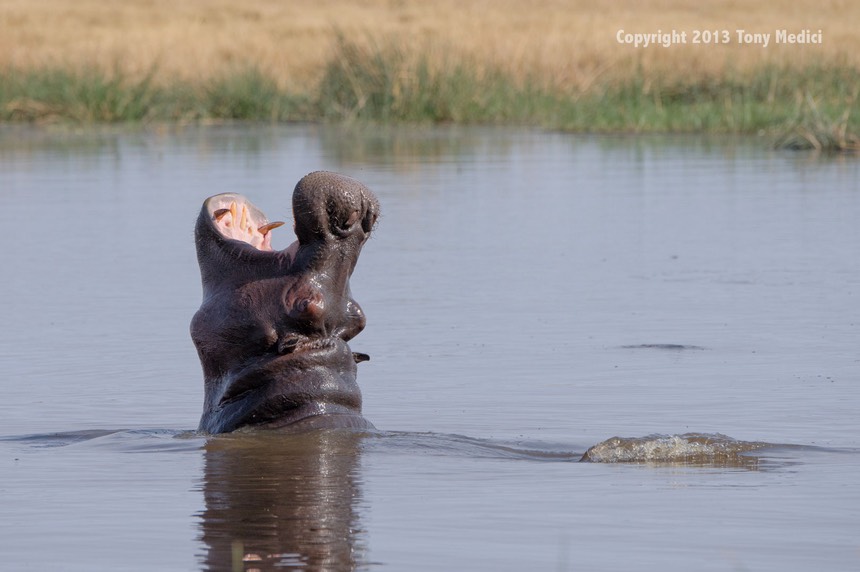
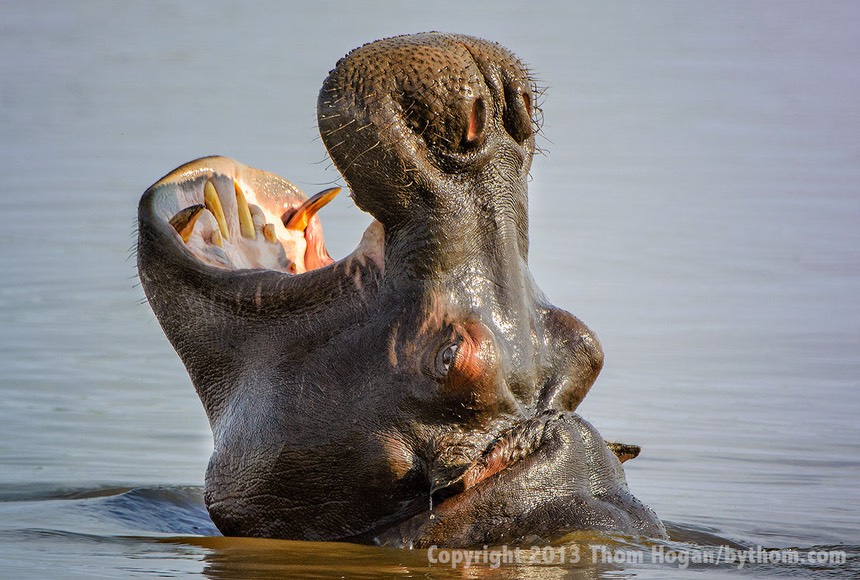
One thing that I was working on this morning was trying to dial back into "birds taking off." You get a lot of that in Africa (birds taking off, that is). Getting the timing right while still nailing focus is tough, even for veterans. Thus, I like to get a head start on my students, making sure I've got that dialed in so I can help them get there, too.
This is where I have to admit to a mistake. One of the cameras I brought with me was a Nikon V2 with the FT1 and a 70-300mm lens, one of the better hand-held wildlife combos available. I guess I picked up the wrong V2 in the office, though. After trying to get those bird lifting on shots with it, I discovered that I didn't have the latest firmware installed, and that's necessary to get continuous autofocus with the FT1 on the camera. Ah, so that's why my focus is off. Like this:

Timing right, focus wrong.
Fortunately, I had asked Tony to bring all the Nikon firmware updates with us just in case any student turned out to not have the latest and greatest. Turns out, I'm the first victim.
This, by the way, is one reason why I so strongly suggest you not be on the constant upgrade path. I have to be, partly because my Web presence requires it, partly because my teaching requires that I be up to speed on everything. Were I just making my living off of images, there's a good chance that I'd still be using a D3s and D3x on this trip. Photographers don't want to keep adjusting things, keep learning new controls, keep testing to see what the limits of something is. They just want to take photos! While they do worry that maybe another pro is getting more pixels on the animals than them (i.e. able to print bigger), that's a minor worry that you should deal with slowly, not something you fret about every six weeks when a new camera is announced. At least that's the way it should be.
We get so gear obsessed because technology does move on and give us better image quality, better focusing, better handling, better capacity, and more, more, more. But we often let that feature and performance parade get too demanding of our attention, and we stop focusing on the pictures and too much on the gear.
Let me give you an example. If I told you that I could give you a camera that shoots as well as a D200, but does 60 fps and comes with a hand-holdable 810mm f/5.6 lens, you'd jump at that, wouldn't you? What if I told you that that camera is a Nikon 1 V2? In actuality, the V2 might actually be better in image quality at ISO 400 or 800, and we're talking about 14mp instead of 10mp. Yet so many people poo-poo the Nikon 1 cameras because it has a small sensor. Pardon my French, but who gives a rats posterior how big the sensor is or isn't? In the end, it's the images you take that are important.
Sure, I could buy a Nikon D4 and a Nikkor 800mm f/5.6 lens and get cleaner high ISO results and be able to shoot inside a coal mine at night, but are the photographs better? Maybe, maybe not. I can't handhold the 800mm f/5.6 lens, so that's going to limit where I can take the combo and use it.
So, one of the following images was taken with a D800 and the 70-200mm versus the V2 and the 200-400mm. Can you tell which one is which?
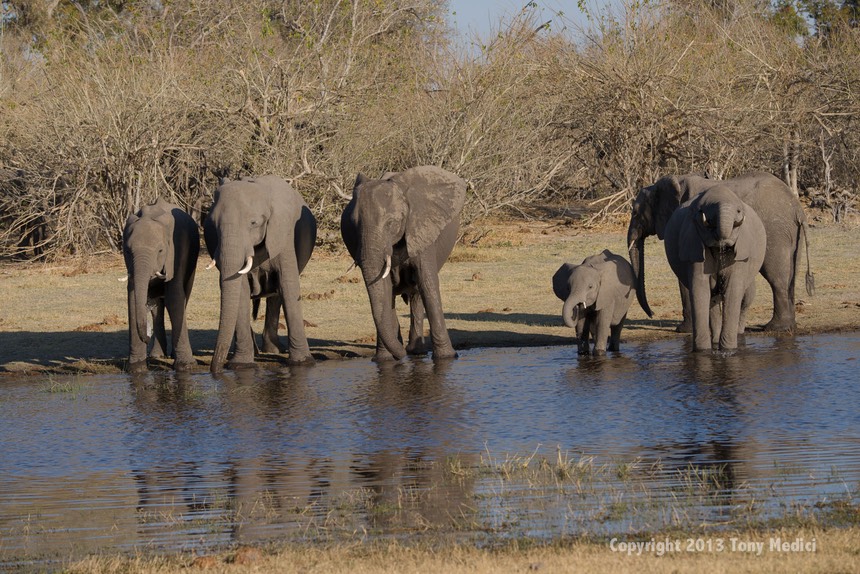
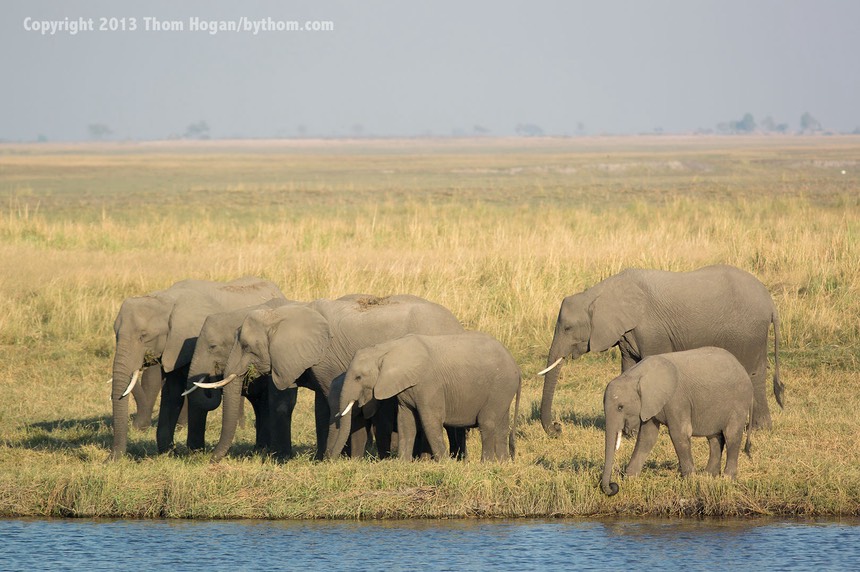
Yeah, I've intentionally made it difficult here. The images were taken on different days, in slightly different light, and in different areas of Botswana. Still, hard to tell, isn't it? Even if I were to give you the post processed full-sized images stripped of EXIF data, most of you wouldn't be able to tell. (Answer, top one is a D800E with 70-200mm, bottom one is a V2 with 200-400mm.)
So before you get too into the "oh, Thom was using state-of-the-art gear for everything and I need that too" type of thinking, realize that we had a pretty wide range of gear on this trip, and I took decent shots with cameras you might not consider anything close to state-of-the-art. Consider:

Gotta be the V2 with a long lens again, right? Nope. This is a JPEG taken with a Sony HX50 compact camera. The giveaway is the sky, which simply can't be held by the 8-bit JPEG from a small sensor when the animal is exposed properly. Just not enough dynamic range in the sensor, especially after the data set is reduced to 8 bits by the camera's heavy-handed processing.
Back to safari-ing.
Our first full afternoon drive turned out to be one of those highlight reel drives.
First, more honey badgers. Only this time, we were able to sneak up on them when they digging for food, and position ourselves in a place that we hoped they would move toward when they finished. Our choice proved to be correct:
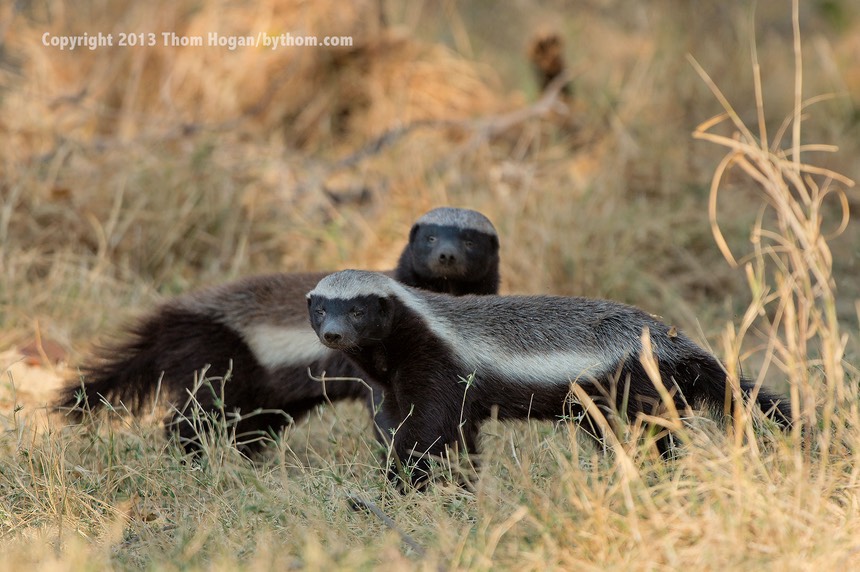
We were four shooting hours into the safari, had seen plenty of cat tracks, heard them roaring, but hadn't yet seen any. Sometimes when that happens, you just continue to skunk out. Any one of the cats can move many kilometers in very short periods, so sometimes it's like you're following them but never quite catching them. Today, however, we caught them. Bang. Bang.
First the leopard. Our driver Betta had spotted movement in a distant tree, and rather than more monkeys, this time it turned out to be an illusive leopard. I say illusive, because the other guides in the area had told Betta that they hadn't seen one in days, yet had seen tracks and other evidence.
Our leopard was skittish, however (we'll get to why in a moment). So we had a bit of trouble getting close to him at first. He came down from the first tree and slinked into the reeds. We caught him coming out a clump of reeds upstream and then he started into what looked like a hunt mode. That means he was moving deliberately, but quickly. Up a termite mount. Spot. Down and up another tree.
It was in the second tree that we were finally able to get a good shot of him. Can you see the leopard in the tree?

Scroll down for the answer.
Here's where you should be looking:

And here's our leopard getting over to that position:
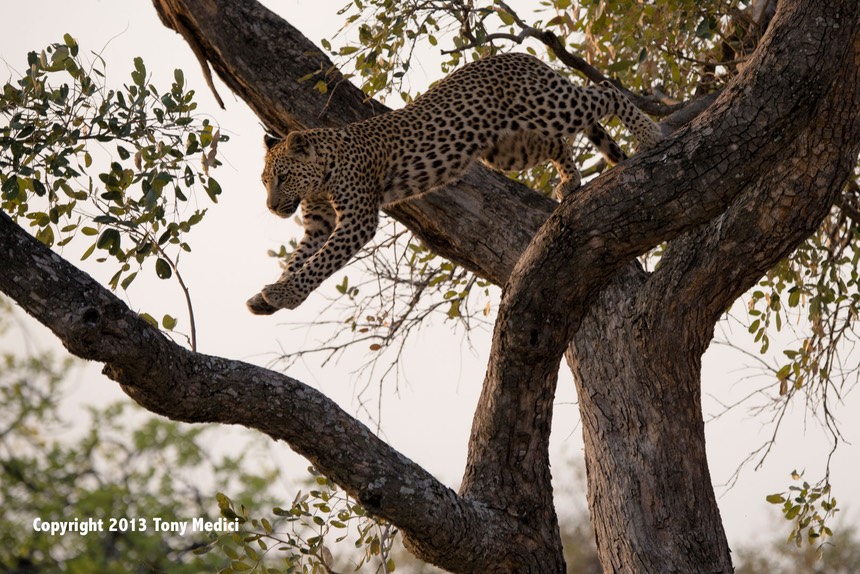
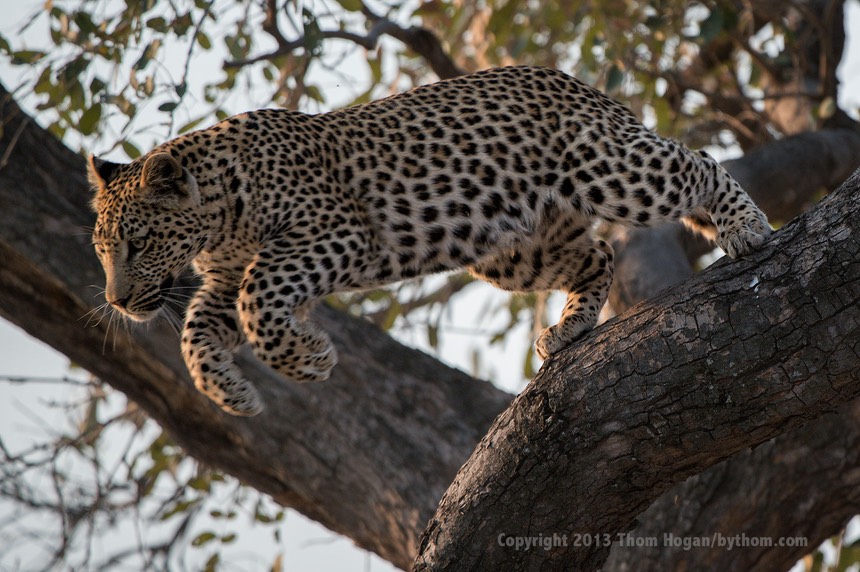
Word got out fast that we had found the leopard; some of the tours at the local permanent camps were ending this evening and hadn't yet seen leopard, so guide tips were on the line. When the third vehicle showed up we started to move out and look for the lions, as one of the vehicles had shared information about where they were last spotted.
And that's why the leopard was skittish. The place we found the lions was only hundreds of yards away, just across the water (I hesitate to say river, as the river is split into so many small streams at this point that it is threading across many dozens of miles). The lions we were looking for were the two dominant males, which roam the pride's territory and try to rid it of competitors such as the leopard. If the lions got wind of the leopard, there surely would be a chase and/or a fight. Our leopard was skittish almost certainly because being downwind he knew where the lions were and we were approaching from the opposite side of that. So if he wanted to get away from us and hunt quietly, he had to do so even closer to the lions than he was.
The lions were deep in the reeds. With their heads down, you wouldn't see them. The reeds are so high here that even tail swishing—one of the ways you often spot them when they're lying down—wouldn't have been seen. Even after they got up to move you could still barely see them:

I have no photos for what happened the last night in camp, as it happened once we were bedded down in our tents. But we found ourselves in chaos central.
Just outside our camp is a fairly recent elephant carcass. Elephants are very respectful of their dead. Hyenas aren't. A pack of hyenas decided that the carcass still had some scraps they wanted to munch on. I was awakened by a massive elephant trumpet. Then another. And another. Not just a trumpet, but a clearly distressed trumpet, and very, very close. For three hours the camp was abuzz with elephants sounding off trying to chase away hyena, hyenas trying to call their pack, and eventually, the elephants pulling down trees and throwing them at hyena. Literally. One of the elephants tore off part of the tree just behind my tent and threw it at the hyena: too dark to take a picture of that, but I could clearly see it with my eyes. Darn it, I had considered bringing the night-IR camera and light, now I already had a reason why I should have.
The fracas started near one end of the camp and ended up just behind our tent, close enough that we were easily feeling the elephant's footsteps as they stomped around. Meanwhile, the hyena were letting out howls from time to time, again starting at one end of camp and ending up behind our tent. If that weren't enough, I heard alarm calls from seven different species around camp, including baboon, impala, kudu, and even one of the birds.
For three hours this cacophony of sounds went on before eventually the hyena gave up and moved off, with the elephants in tow. The last sounds I heard were jackal yips, but apparently the elephant weren't mad at them as there were no more trumpets.
It's just a reminder that safaris aren't just about images, but the entire experience, including the smells and sounds. And remember when I wrote that sleep might be intermittent in the coming days? ;~)
Tony and I had one additional day of pre-safari safari. Here are a few images from that time:


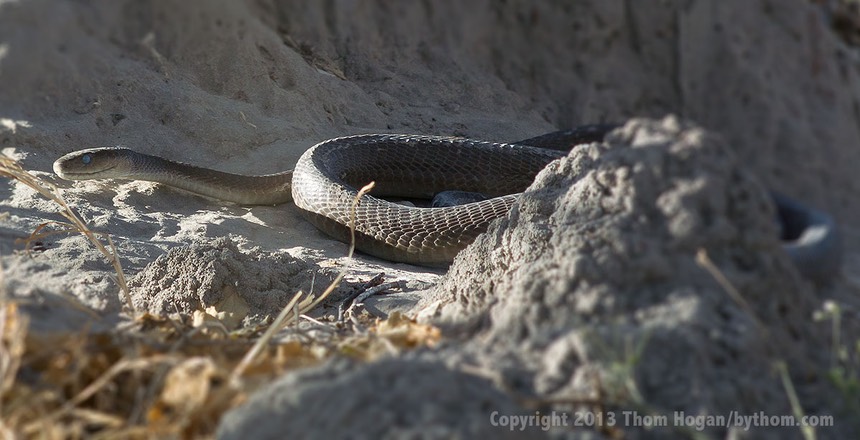
Yes, that's a black mamba. Yes, I'm still alive. And yes, I took this photo (cropped top and bottom only) with my longest lens.